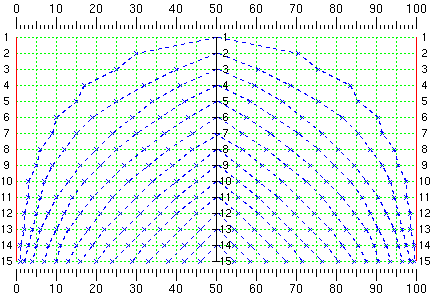
 |
The chart above is based on Kit Woolsey's Match Equity Table . All 15-point match equity data in the table are plotted so that match equity of each score can be read from the gauge placed on the top and the bottom of the chart.For explanations on how to use the chart, click here.
Score Matrix
Main use of the match equity chart is probably to study cube action problems for particular match scores. Without bringing a lot of match equity numbers from the match equity table , you can visualize most important characteristic of the score and the scores that are possible outcomes after the game (or maybe at the next cube action in the same game) fairly easily, very quickly.Most of the time, you don't need to do any calculation. All you have to do is visually compare length of lines.
See the "Score Matrix", that is collection of the match equity charts showing gain/risk arrows for different match scores (currently all scores up to 9 point matches are ready).
Money Game "Equity Chart"
Cube actions in money games are, in general, thought to be much easier than those in match playes. Why?Comments like "This is an easy money take, but at this score ...", or "I wouldn't double this position in a money game, but .." are often heard. What exactly do those mean?
Comparing the match equity charts with money game "equity charts" may give you some good ideas for the answers to those questions.
Here is the Snowie's match equity in GIF format. (Full size GIF) Comparison between Woolsey's and Snowie's and other studies are (probably) coming soon.
The Fish Effects
![]()
| See: |
Other articles by Sho Sengoku
Other articles on Match Equities |
| Return to: | Backgammon Galore : Articles |